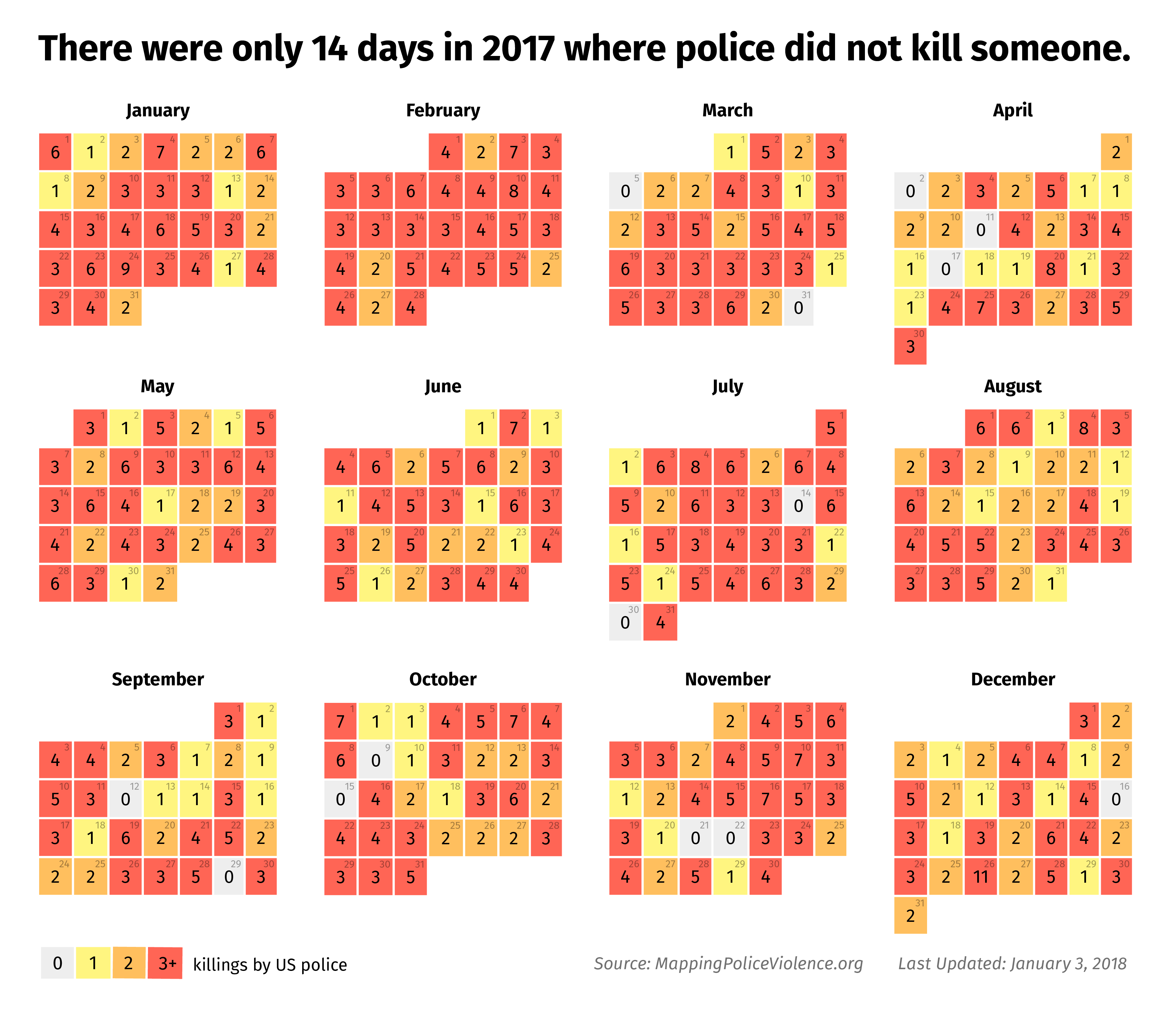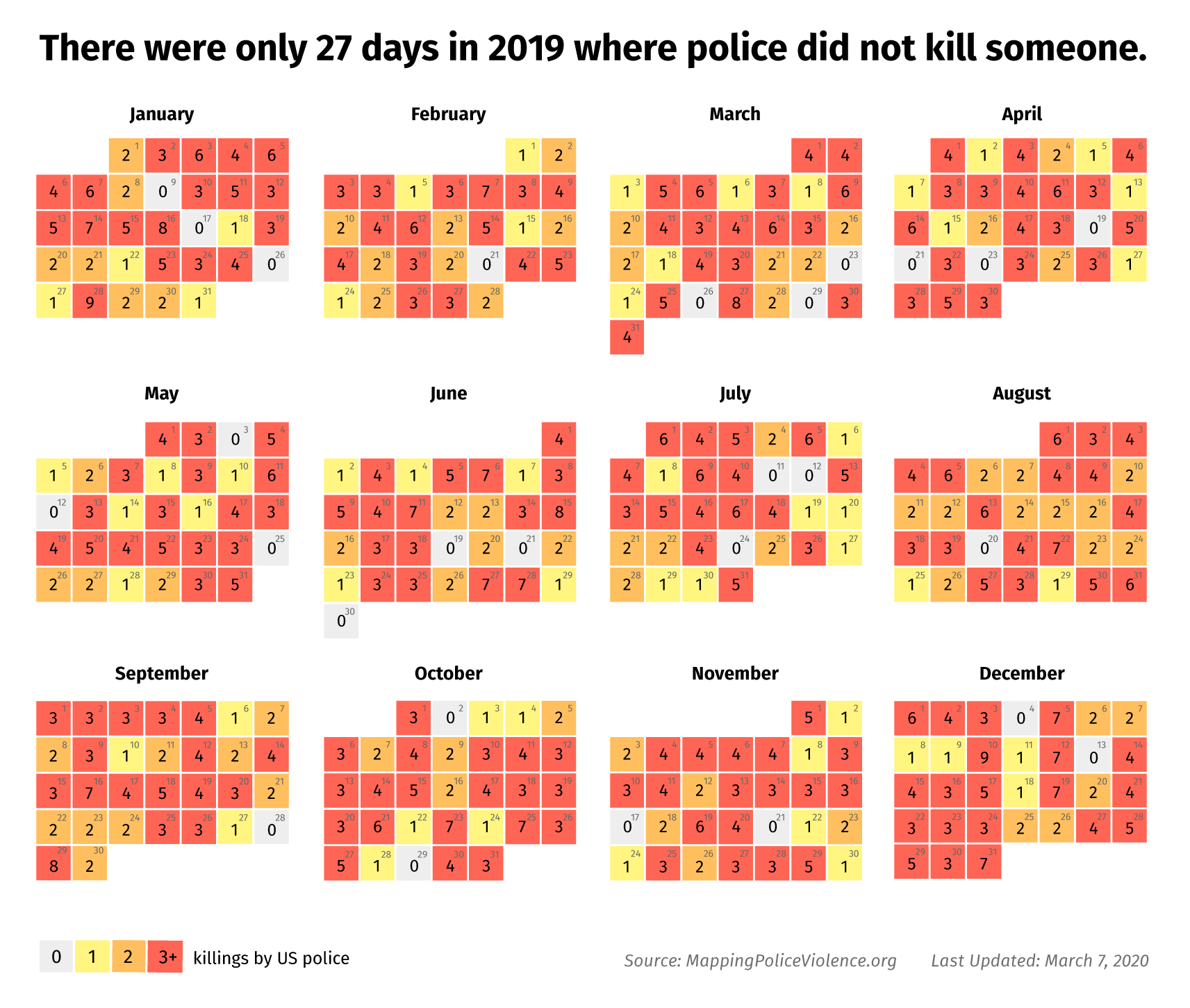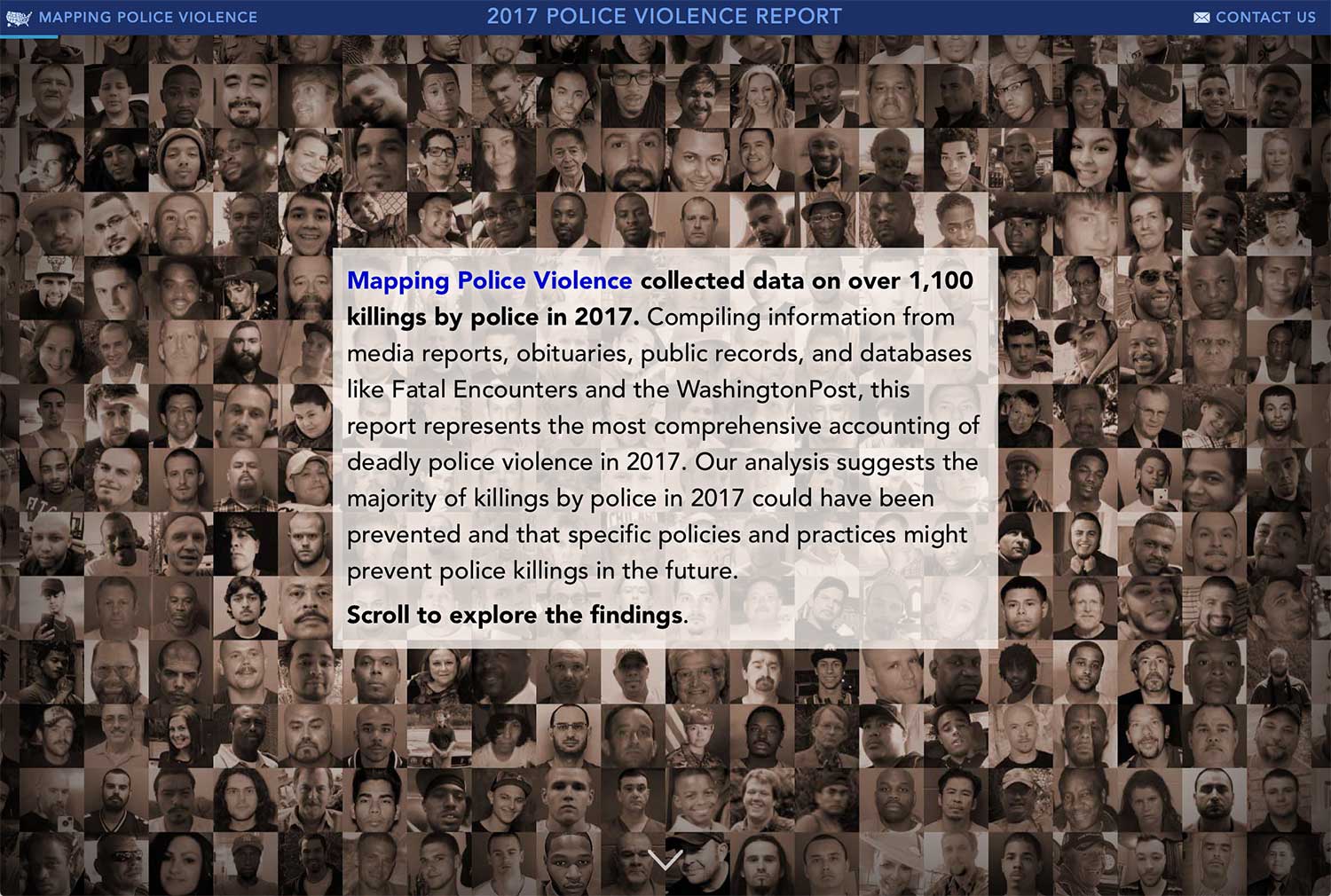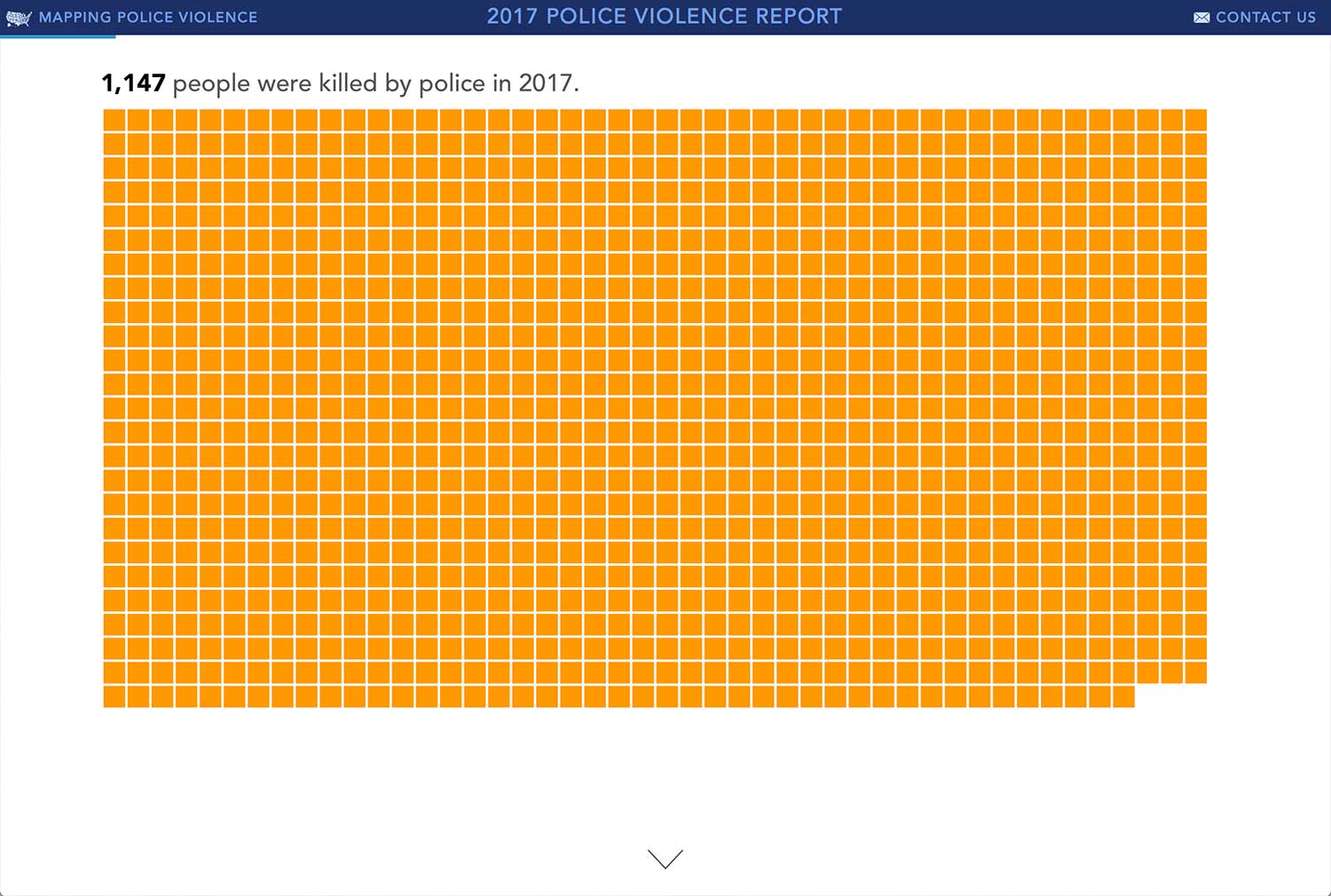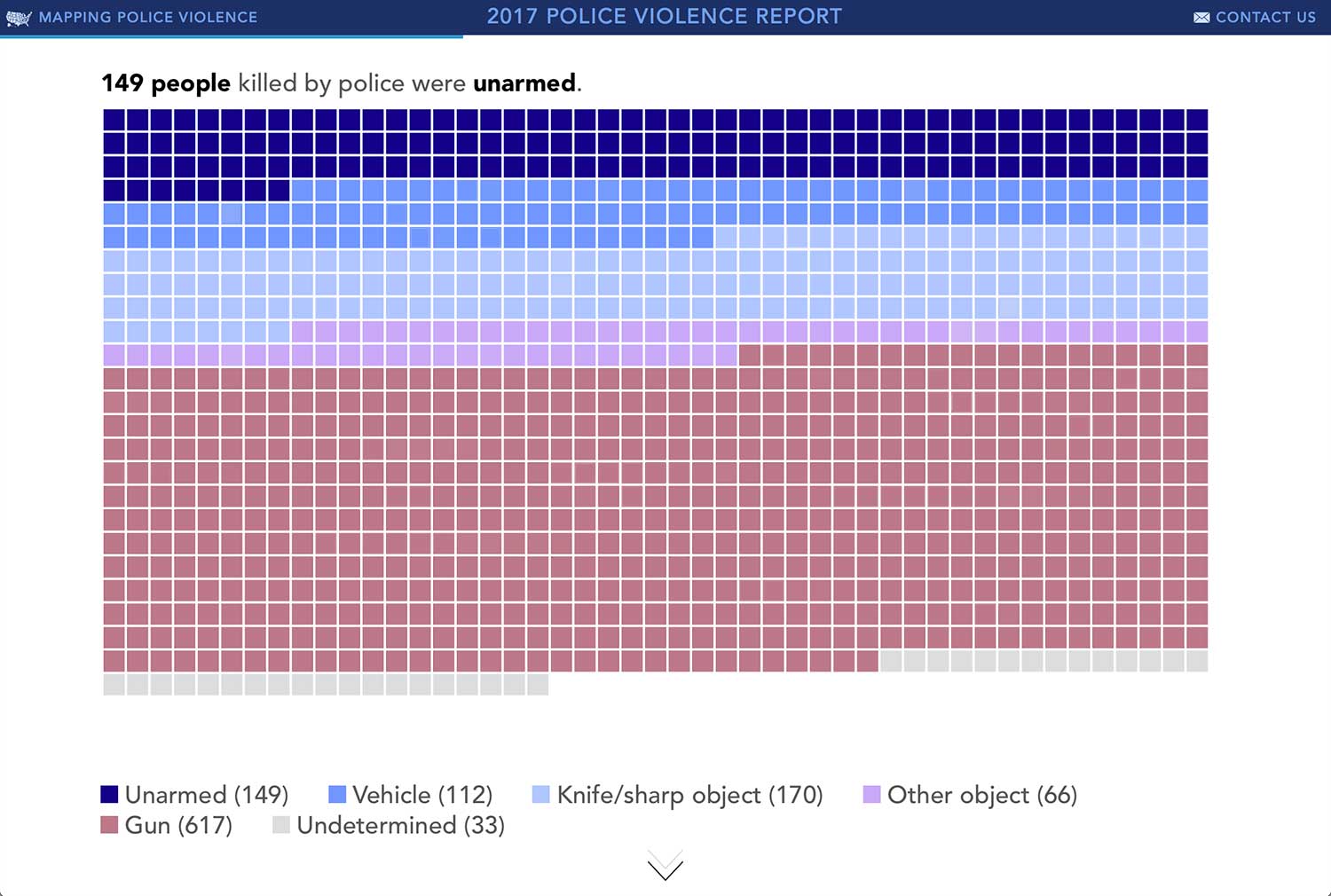Found 3599 matches from 1,400 records in about 0.1134 seconds for twitter or is or lazy. " class="mlpt">Calendar of Killings by Police
In January 2021, it was updated with analysis of the 1,127 people killed by police in 2020.
" class="mlpt">Police Violence ReportToolkit Now Available
Using data visualization can improve the effectiveness of human rights work that involves data. In particular, combining data and visuals in the promotion of human rights enables advocates to harness the power of both statistics and narrative. Visualizing data can facilitate audiences' understanding of abuses and motivate people to take action. When used as a tool in human rights research, it can help investigators identify patterns and see the connections among individual rights violations.
To introduce researchers to topics and principles of data visualization for human rights, we developed a toolkit that can be used on its own or as a data visualization workshop activity. The kit contains 6 chapters that take practitioners step by step through the following:
- Human rights and related data resources
- Data types and collection methods
- Questions to interrogate human rights issues with data and visualization
- Some common chart types
- Data collection and visualization hazards
- Tips for improving data visualization
Each chapter is set out succinctly as a bite-sized summary of a larger data visualization topic. It is our hope that the kit will speak to students as well as human rights experts, and that it rewards both casual browsing and careful review. The chapters can stand alone or be used as a sequence of steps in a workshop aimed at preparing rights practitioners for informed and strategic use of data visualization.
The kit is available online at visualizingrights.org/kit and can also be downloaded as a series of PDF booklets.
Our project is the result of a research collaboration between the Center for Human Rights and Global Justice and the Tandon School of Engineering at New York University, and was funded with a grant from the John D. and Catherine T. MacArthur Foundation. These data visualization guidelines were authored by John Emerson and Margaret Satterthwaite with help from contributors Brianne Cuffe, Sidra Mahfooz, and Deirdre Dlugoleski, and input from Enrico Bertini, Oded Nov, and NGO colleagues and participants in the Responsible Data Forum.
“[Dr. Chalmers] testified that the Klan had four basic components. One is what he called ‘one hundred percent Americanism.’ The Klan is as old as apple pie in the United States, and has always been what they called in the old days a ‘native American party.’ I’m not speaking of Native Americans as we ordinarily think of them… Their notion was that no one but whites from Northern Europe should be here on these shores. The Klan is a continuation of that ideology.
A second component is moral conformity, which I spoke of earlier. Third, the notion of fraternity, of brotherhood. And finally, and most important to us at any rate, is the notion of violent action. They do something about the problems.
Most of the rank-and-file Klansmen, at least the ones I encountered in Chattanooga, were poor, uneducated, working-class whites. And the Klan gave them something to be proud of; it gave them a perspective, a purpose. And that’s the attraction the Klan has for white working-class America. And unless you all can develop some other method, or some other means of expression, you won’t be able to defeat the Klan.”
“The motivation for people to join violent extremist groups in Syria and Iraq remains more personal than political… [ISIS propaganda] appeals to those who seek a new beginning rather than revenge for past acts. A search for belonging, purpose, adventure, and friendship, appear to remain the main reasons for people to join the Islamic State.…
Our results suggest that it is not so much the lack of material resources that is important for terrorism but rather the lack of economic opportunities: Countries that restrict economic freedom experience more terrorism.… While unemployment on its own does not impact radicalization, unemployment… leads to a greater probability of radicalization.…
The validation of the influence of friendship in motivating individuals to become [foreign terrorist fighters] supports the ‘bunch of guys’ theory of terrorism put forward by the psychologist Marc Sageman, who argues that the decision to join a terrorist group ‘was based on pre–existing friendship’ ties and ‘that the evolving group of future perpetrators seemed more akin to’ such networks ‘than a formal terrorist cell, with well–defined hierarchy and division of labour.’ This theory has led some observers to call for a ‘social network approach to terrorism’”
On becoming MS13 in the Americas (2018) (via)
“The MS13 is a social organization first, and a criminal organization second. The MS13 is a complex phenomenon. The gang is not about generating revenue as much as it is about creating a collective identity that is constructed and reinforced by shared, often criminal experiences, especially acts of violence and expressions of social control. The MS13 draws on a mythic notion of community, a team concept, and an ideology based on its bloody fight with its chief rival, the Barrio 18 (18th Street) gang, to sustain a huge, loosely organized social and criminal organization.…
In conversations, gang members make clear that it is centered on the notion of community, which they loosely refer to as ‘el barrio.’
El barrio encompasses the best and the worst of the gang, an expression of its bipolar personality that is the defining characteristic of this group. El barrio is a physical space. It has borders, and the gang marks those borders with graffiti and other public symbols. It posts its members at the edges of these borders to ensure others do not encroach on its space, and members protect this space with their lives, if necessary. It draws revenue from this territory and, in some cases, builds social and political ties with its residents, even while it is victimizing them.
But el barrio is also psychological. What seems to bind all these groups is that they are looking for a sense of place: a space where they can get protection and nurturing - both positive and negative; a space where others are supportive of one another; a space it can call its own, henceforth its near constant references and symbols that beckon the homeland. That space is what they call el barrio.”
Update, August 22, 2021: this Twitter thread from a former Islamist echoes this theme as well.
From Sasha Costanza-Chock, Design Justice: towards an intersectional feminist framework for design theory and practice:
"Design is key to our collective liberation, but most design processes today reproduce inequalities structured by what Black feminist scholars call the matrix of domination. Intersecting inequalities are manifest at all levels of the design process. This paper builds upon the Design Justice Principles, developed by an emerging network of designers and community organizers, to propose a working definition of design justice: Design justice is a eld of theory and practice that is concerned with how the design of objects and systems influences the distribution of risks, harms, and benefits among various groups of people. Design justice focuses on the ways that design reproduces, is reproduced by, and/or challenges the matrix of domination (white supremacy, heteropatriarchy, capitalism, and settler colonialism). Design justice is also a growing social movement that aims to ensure a more equitable distribution of design's benefits and burdens; fair and meaningful participation in design decisions; and recognition of community based design traditions, knowledge, and practices."
This is a great start.
Update, March 2020: Sasha turned this into a book! Design Justice: Community-Led Practices to Build the Worlds We Need
Update, August 2020: The book is now online.



